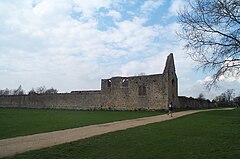Godstow
| Godstow | |
|---|---|
 Godstow Abbey ruins |
|
| Godstow shown within Oxfordshire | |
| OS grid reference | SP484091 |
| District | |
| Shire county | |
| Region | |
| Country | England |
| Sovereign state | United Kingdom |
| Post town | Oxford |
| Postcode district | OX2 |
| Dialling code | 01865 |
| Police | Thames Valley |
| Fire | Oxfordshire |
| Ambulance | South Central |
| EU Parliament | South East England |
| UK Parliament | |
Godstow is a hamlet on the River Thames about 2.5 miles (4 km) northwest of the centre of Oxford. The ruins of Godstow Abbey, or Godstow Nunnery, are here.
Godstow Abbey was built on what was then an island between streams running into the River Thames. The site was given to the foundress Edith, widow of Sir William Launceline, in 1133 by John of St. John and built in local limestone in honour ofSt Mary and St John the Baptist for Benedictine nuns; with a further gift of land from him, the site was later enlarged. The church was consecrated in 1139.
The abbey was again enlarged between 1176 and 1188 when Henry II gave the establishment £258 (which included £100 for the church), 40,000 shingles, 4,000 laths, and a large quantity of timber. Because the abbey was the burial place of his mistress Rosamund Clifford, Henry, who received patronal rights from the nuns, paid special favour to the Abbey.
The abbey was suppressed in 1539 under the Second Act of Dissolution.
The Abbey precincts were entered from the Wolvercote-Wytham road, which ran through the outer court. Here there was a two-storey main gatehouse which had one large gate for carts and a second smaller one beside it for foot traffic.
The site consisted of a guest house; a nunnery; an outer court containing a range of buildings; lodging for a priest; St Thomas's chapel which appears to have been used a church by the Abbey's servants; and the Abbey church, which contained cloisters along with associated buildings.
George Price Boyce, the Victorian watercolour painter associated with the Pre-Raphaelite art movement, visited and painted the nunnery in 1862.
The abbey was the final burial place of the famed beauty Rosamund Clifford (died c. 1176), a long-term mistress of Henry II. Henry's liaison with Rosamund became known throughout court in 1174; it ended when she retired to the nunnery at Godstow in 1176, shortly before her death.
...
Wikipedia

